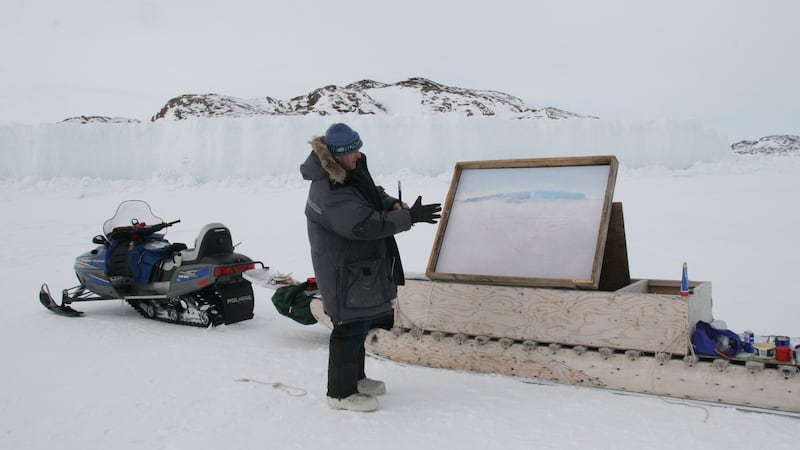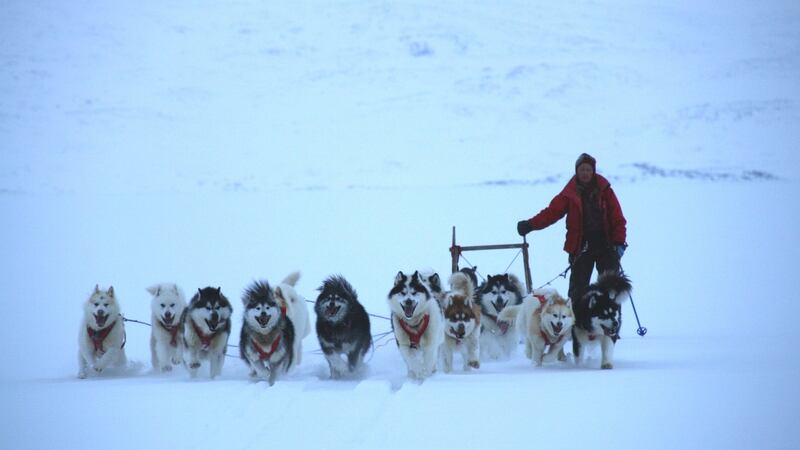Few of us become so absorbed by our Atlantic coastline that it sends us off on a lifetime's odyssey, training a team of huskies to explore the high Arctic and leading a pack of llamas on an expedition into the high altitude deserts of Chile.
Artists have long been enchanted by our western seaboard, from Sean Scully and Tim Robinson to Paul Henry, but Danny Osborne took his enchantment further.
“It was the huge areas of bare rock and almost lunar-like landscape that grabbed me,” says Osborne of his reaction to west Cork’s Beara peninsula when he first arrived from England in 1971.
“I began to see the postglacial landscape that is here; the effects of huge erratics and the rocks smoothed by the ice. My fixation with this underlying geology was getting more and more extreme, until I decided that I needed to go to the source, go to the Arctic, which is what I did in 1977 to paint the landscape, and I’ve been going ever since.”
Osborne led the first ever Irish Arctic Expedition in 1981 with Gerry Wardell, which led to art exhibitions in Dublin and Kilkenny and an RTÉ film, Beyond the North Wind. Afterwards he returned to Cork and began dating a medical student, Geraldine, who had helped pack the seven tons of expedition equipment for the trip. Within a few years they were married and planning a trip of their own.

“Geraldine didn’t want to go to the Arctic, and as I had an interest in volcanoes and lava because of my fixation with the geology of the Beara peninsula, we decided to buy a team of llamas and head off to Chile, through what we thought was probably the largest collection of volcanoes in the world.”
Months training llamas
It took a year to organise the trip, and then months to train llamas to carry cargo before they “set off in the middle of winter from San Pedro de Atacama into the high Cordilleras, which locals regarded as suicidal,” Geraldine recalls. She was by this time a qualified doctor and a mother of six-month-old Tempy.
“Everything we possessed was lashed to our animals, including heavy camera equipment and film stock. We were heading for a remote, uninhabited and incompletely mapped area of northern Chile.”
For Osborne the goal was to engage with a geology similar to that on Beara. “It’s difficult to separate the desire for expedition with the artistic urge. Art is a form of exploration, discovering new things and then playing around with the ideas that come from them. The attraction of going somewhere unvisited is a huge draw.”
They led their llamas through snow troughs filled with massive icy spikes and around active lava flows, while Geraldine dealt with the early months of pregnancy. They also conducted scientific research on red blood cells and filmed a documentary, Halfway to Heaven, which was shown on RTÉ for many years after.
On returning to Beara, Danny continued to paint and Geraldine established herself as a GP, but by 1989 Danny’s urge to reconnect more deeply with the Arctic arose again. He convinced his wife to head off to Canada’s most northerly community, Grise Fjord, with their children Tempy (then 5), Orla (2½), and Oisín (1).

For a young family to suddenly start eating raw fish and meat, and dressing in caribou skins to cope with minus-40-degree temperatures was a challenge, but Danny was determined to experience the full intensity of wilderness, and so proceeded to reintroduce husky sleds into a culture that was already using snowmobiles.
Trained dogs Over their first winter he trained a team of dogs in the wilds of Ellesmere island in preparation for a family trip from Greenland across the sea-ice to Canada.
“There is a huge adrenaline rush to accumulating skills to avoid trouble in a hostile environment,” he says. “And I was able to work my art into that.”
He built a sledge and a box for the children to shelter in on long journeys and flew them all to Greenland, where locals still hunted walrus while dressed in polar-bear skins and sealskin boots. But, as Geraldine recalls, “Whether global warming or just a whim of nature, the sea ice had melted unseasonably early and we were not able to get back over the ice cap to Canada. We had to charter a plane home to Grise Fjord.”
They headed south instead with their dogs over the sea ice towards Devon Island. “No white people have done such long journeys by dog team with kids before,” says Geraldine. “Avoiding cracks in the sea ice was the most challenging aspect, but it just whetted our appetite for more trips.”
They returned to Beara after a year, and Geraldine settled into a life as a public health doctor, while Danny continued to travel to volcanic and Arctic regions lured by their various rock formations.

The full intensity of his geological obsession is evident in his 1997 sculpture of Oscar Wilde in Merrion Square, which excites geologists because of the complexity and diversity of its stone, from the green nephrite jade of Wilde’s jacket to the pink Norwegian thulite of his collar and cuffs.
Going native in Nunavut
Osborne returned to Canada’s High Arctic every year to paint, and when the region was finally designated an independent territory, Nunavut, in 1999, the Osbornes wanted to be a part of it.
Geraldine got a job as associate chief medical officer of the new province. “I promised I’d be back in Cork within two years, but we ended up staying for 13 years. “It was an immensely rewarding experience to assist an indigenous population coping with a rapid transition into the modern world. The biggest challenge was mental-health issues from the stresses of acculturation; and diseases too, such as TB and diabetes that the Inuit never had when they were living their traditional nomadic lifestyle.”
Geraldine became chief medical officer for the territory, and her two youngest children, Orla and Oisín, spent their teenage years there.
“The media often focuses on the dysfunctionality of Nunavut,” she says, “but the fact that their fate is no longer controlled by Ottawa has given them self-respect, and means their future is a lot brighter.”
However, Danny says: “Their language is disappearing, and they are aware of losing so much else. They literally moved from the Stone Age to modern technology in one big jump.”
The Osbornes returned to Beara in 2014, although “We both miss the place so much,” says Danny.
In the past decade he has combined his obsessions with art and geology by casting sculptures out of red-hot lava flowing down the side of an erupting volcano in Guatamala. He dipped bronze moulds into the intense heat and fumes of molten lava to create art.

It marks the epitome of his lifetime’s obsession with the destructive and constructive battle that ensues wherever rock encounters its nemesis, whether that be west Cork waves, Arctic sea ice or Central American volcano.
Danny Osborne's art can be seen at the Landmarks and Lifeforms exhibition in West Cork Arts Centre until April 20th. It will then tour to Limerick City Gallery of Art and Highlanes Gallery, Droghedawestcorkartscentre.com dannyosborne.com


















